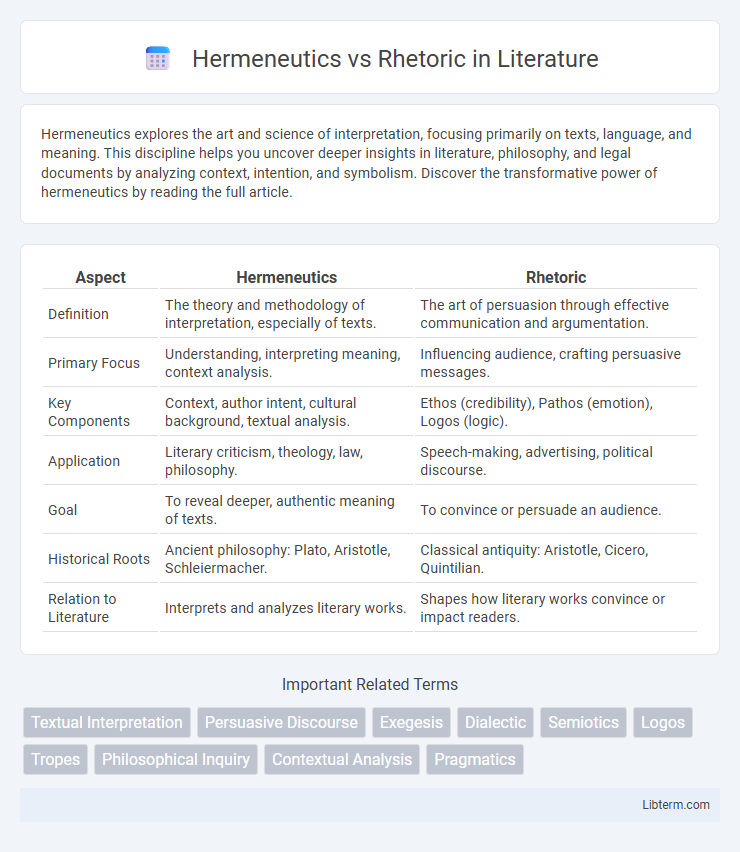Hermeneutics explores the art and science of interpretation, focusing primarily on texts, language, and meaning. This discipline helps you uncover deeper insights in literature, philosophy, and legal documents by analyzing context, intention, and symbolism. Discover the transformative power of hermeneutics by reading the full article.
Table of Comparison
| Aspect | Hermeneutics | Rhetoric |
|---|---|---|
| Definition | The theory and methodology of interpretation, especially of texts. | The art of persuasion through effective communication and argumentation. |
| Primary Focus | Understanding, interpreting meaning, context analysis. | Influencing audience, crafting persuasive messages. |
| Key Components | Context, author intent, cultural background, textual analysis. | Ethos (credibility), Pathos (emotion), Logos (logic). |
| Application | Literary criticism, theology, law, philosophy. | Speech-making, advertising, political discourse. |
| Goal | To reveal deeper, authentic meaning of texts. | To convince or persuade an audience. |
| Historical Roots | Ancient philosophy: Plato, Aristotle, Schleiermacher. | Classical antiquity: Aristotle, Cicero, Quintilian. |
| Relation to Literature | Interprets and analyzes literary works. | Shapes how literary works convince or impact readers. |
Defining Hermeneutics and Rhetoric
Hermeneutics is the theory and methodology of interpreting texts, especially sacred and literary works, focusing on understanding meaning within historical and cultural contexts. Rhetoric, by contrast, is the art of persuasion through effective communication, emphasizing strategies to influence audiences using ethos, pathos, and logos. While hermeneutics seeks to uncover and clarify underlying meanings, rhetoric aims to shape and direct audience response through stylistic and argumentative techniques.
Historical Roots and Philosophical Foundations
Hermeneutics, rooted in ancient Greek philosophy and expanded by thinkers like Schleiermacher and Gadamer, emphasizes the interpretation of texts, aiming to uncover underlying meanings through context, history, and authorial intent. Rhetoric, tracing back to Aristotle's foundational works, focuses on persuasion and effective communication, examining strategies for influencing audiences through ethos, pathos, and logos. Both disciplines share classical origins but diverge philosophically: hermeneutics seeks understanding, while rhetoric prioritizes articulation and argumentative impact.
Core Principles: Interpretation vs. Persuasion
Hermeneutics centers on interpretation, aiming to uncover the meaning behind texts, symbols, or spoken words by applying context, historical background, and linguistic analysis. Rhetoric focuses on persuasion, employing strategies such as ethos, pathos, and logos to influence an audience's beliefs, attitudes, or actions. The core difference lies in hermeneutics seeking understanding and clarity, while rhetoric prioritizes effective communication to persuade or motivate.
Key Figures in Hermeneutics and Rhetoric
Key figures in hermeneutics include Friedrich Schleiermacher, who emphasized understanding the author's intent, and Hans-Georg Gadamer, known for his philosophical hermeneutics focusing on historical context and dialogue. In rhetoric, Aristotle stands as a foundational figure with his articulation of ethos, pathos, and logos, while Cicero and Quintilian contributed significantly to classical rhetorical theory and education. Both disciplines intersect in figures like Paul Ricoeur, who bridged hermeneutic interpretation and rhetorical analysis.
Methodological Approaches Compared
Hermeneutics emphasizes interpretative methods aimed at understanding texts, context, and meaning through a dialogical process between the interpreter and the source material. Rhetoric centers on persuasive techniques, focusing on strategies employed to influence audiences through effective communication and argumentation. Methodologically, hermeneutics uses cyclical interpretation and contextual analysis, whereas rhetoric applies principles of ethos, pathos, and logos to craft and evaluate discourse.
Language, Meaning, and Context
Hermeneutics examines language through the lens of interpretation, emphasizing the role of context and historical background in uncovering meaning within texts. Rhetoric centers on the strategic use of language to persuade and influence audiences, highlighting the impact of style, delivery, and situational factors on communication effectiveness. Both fields recognize that meaning is not fixed but shaped by linguistic choices and the interplay between speaker, text, and context.
Applications in Literary and Textual Analysis
Hermeneutics applies deep interpretive techniques to uncover multiple layers of meaning in literary and textual analysis, emphasizing context, authorial intent, and historical background. Rhetoric focuses on the strategies and persuasive techniques employed in texts to influence readers and shape responses, analyzing elements such as ethos, pathos, and logos. Both disciplines enhance understanding by examining how meaning is constructed and communicated through language, with hermeneutics prioritizing interpretation and rhetoric emphasizing effective persuasion.
Influence on Modern Communication Studies
Hermeneutics, emphasizing interpretation and meaning-making, shapes modern communication studies by enhancing understanding of textual and contextual nuances in messages. Rhetoric contributes by focusing on persuasive strategies, influencing how communicators craft arguments and engage audiences effectively. Together, these disciplines inform critical analysis of communication processes, improving media literacy, interpersonal communication, and discourse analysis.
Contemporary Debates and Critiques
Hermeneutics, emphasizing interpretative methodologies and meaning-making, faces critiques for potential subjective bias in contemporary debates, contrasting with rhetoric's focus on persuasive communication and strategic argumentation. Scholars argue that hermeneutics struggles with relativism in interpreting texts, while rhetoric is critiqued for prioritizing persuasion over truth. Current discussions explore integrating hermeneutic depth with rhetorical clarity to enhance discourse ethics and practical communication efficacy.
Integrating Hermeneutics and Rhetoric in Practice
Integrating hermeneutics and rhetoric enhances interpretative depth and persuasive communication by merging comprehensive textual analysis with strategic audience engagement. Hermeneutics provides a framework for understanding context, meaning, and intent, while rhetoric employs those insights to craft compelling arguments tailored to specific audiences. This synergistic approach is vital in disciplines like law, theology, and communication, where interpretation and persuasion intersect to influence understanding and action.
Hermeneutics Infographic

 libterm.com
libterm.com